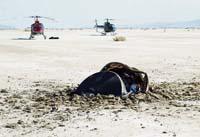The Genesis mission was not useless work

In 2001 a spacecraft was sent to study the winds of the sun on the Genesis mission. After 27 months in space and after satisfactory work, i.e. a lot of data, when landing the spacecraft, the parachute failed and fell in the Utah desert.
When they saw what happened, the scientists thought that all the information that the ship collected had been lost, but they began to analyze it and saw that there was information, that it had not been lost. Of course, it took much longer than was expected at first to get that information out of the spacecraft's pieces: in the first year it was thought that the results would be published and three years have passed until they began to be published.
Although it has taken a long time, the information obtained has been considered very useful, since they have known, among other things, the proportion of isotopes of the surface elements of the Sun. Astronomers believe that the composition of the surface of the Sun is the same as that of the precursor of the Solar System, before the formation of the stars and planets of the Solar System. According to them, the data obtained will serve to know how the Earth's atmosphere occurred.
Buletina
Bidali zure helbide elektronikoa eta jaso asteroko buletina zure sarrera-ontzian











